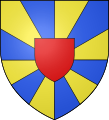Philip I (Flanders)
Philip of Alsace († June 1, 1191 near Akkon ) was a Count of Flanders from the House of Châtenois . He was a son of Count Dietrich von Flanders (called Dietrich von Elsass) and the Sibylle von Anjou .
Life
Philip's first marriage in 1159 was Elisabeth (Mabile), daughter of Count Rudolf I of Vermandois , who inherited the Vermandois from her brother in 1167 , which shifted the weight of the county of Flanders to the south and threatened the balance of power in northern France . In 1168 Philip took Count Florens III. caught by Holland , whom he forced to pay homage to Zeeland . Together with his brother Matthew and King Ludwig VII of France , he supported the young Heinrich from 1173 in his revolt against his father, the English King Heinrich II. Plantagenet . Young Heinrich promised him the English county of Kent if he succeeded . In Normandy, Philipp conquered Nauchâtel-en-Bray and Aumale and besieged Rouen from July to August 1174 , which he had to give up after Heinrich Plantagenet was relieved. His ally in England, Robert de Beaumont, 3rd Earl of Leicester , was also defeated in the Battle of Fornham .

Second from the right, Count Philipp as swordtail. ( Jean Fouquet )
From 1177 to 1179 Philip undertook together with William de Mandeville a crusade to the Holy Land , where he turned down an offer to rule the Kingdom of Jerusalem and the Prince Bohemond III. assisted by Antioch in the siege of Harim .
Back in his homeland, Philip continued to expand his administrative apparatus and had Gravensteen Castle built near Ghent . In his time Flanders reached a high point of economic prosperity, which made Philip one of the richest princes. He became a tutor of Crown Prince Philip II August , whom he married to his niece Isabella of Hainaut in 1180 and gave Artois as a dowry. He also supported his protégé when he came to power in the same year against the Counts of Champagne . In 1182, however, a conflict developed between Philip and the king himself after his wife Elisabeth (Mabile) died childless and he got into a dispute with his sister-in-law Eleonore over the Vermandois. The conflict was resolved by treaty in 1185 by allowing Philip to remain in possession of the county of Vermandois until his death.
Philip took part in the Third Crusade , especially the siege of Acre , in which he - like many other participants - died. He was buried in the Cathedral of St. Nicolas in Acre , but later transferred to Clairvaux Abbey by his widow . His demise caused Philip August, who was also present there, after the surrender of Acon, to end his participation in the Third Crusade in order to arrange for Philip's succession in his French possessions in his home country. He left the eastern part of the county to Mabiles sister Eleanor until he moved in her property in 1213 after her childless death, and took possession of the western part himself.
Philip of Alsace had married Mathilde of Portugal in August 1183 , a daughter of Alfonso I , the first king of the country. Since this marriage also remained childless, his sister Margarete and her husband Balduin V. Count von Hainaut inherited his Flemish possessions.
The author Chrétien de Troyes dedicated his last unfinished work to Philip, Li Contes del Graal .
coat of arms
Philip of Alsace is the first known Count of Flanders to bear a coat of arms. According to the chronicle of the Abbey of Saint-Bertin, written down in the late 14th century by the monk Johannes the Long (also called Johannes von Ypres) , Philip killed a "King of Albania" in a duel during a crusade in the Holy Land and then his coat of arms, a Lions on a golden shield, taken in isolation. With this he immediately replaced the coat of arms of his ancestors, the "Oude Vlaenderen".
Regardless of this story, the Flemish lion coat of arms for Count Philipp is contemporary on a seal from the year 1162, i.e. several years before he set out on his first crusade in 1177. The older coat of arms supposedly replaced by him ("Oude Vlaenderen") is purely legendary, and it is not known whether it was ever carried by a count. Today it is still used as a flag by the Belgian province of West Flanders .
literature
- Alexander Cartellieri : Philip, Count of Flanders . In: Allgemeine Deutsche Biographie (ADB). Volume 53, Duncker & Humblot, Leipzig 1907, pp. 50-53.
Individual evidence
- ↑ Chronica monasterii Sancti Bertini auctore Iohanne Longo. Edited by Oswald Holder-Egger . In: Gesta saec. XIII (= Monumenta Germaniae Historica . 1: Scriptores. 5: Scriptores (in Folio). Vol. 25, ISSN 0343-2157 ). Hahn, Hannover 1880, pp. 736–866 .
- ↑ Roger Harmignies: Notes à propos du lion de Philippe d'Alsace, comte de Flandre. In: Archivum Heraldicum. Vol. 84, 1970, ISSN 0004-0673 , pp. 24-26.
Web links
- Philippe de Flandre at fmg.ac
| predecessor | Office | successor |
|---|---|---|
| Dietrich I. |
Count of Flanders 1168–1191 |
Margaret I. |
| Rudolf II. |
Count of Vermandois Count of Valois (de iure uxoris ) 1167–1191 |
Eleanor |
| personal data | |
|---|---|
| SURNAME | Philip I. |
| ALTERNATIVE NAMES | Philip of Alsace |
| BRIEF DESCRIPTION | Count of Flanders |
| DATE OF BIRTH | 12th Century |
| DATE OF DEATH | June 1, 1191 |
| Place of death | at Acre |


